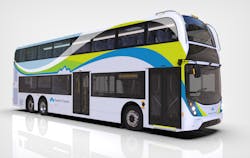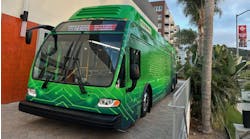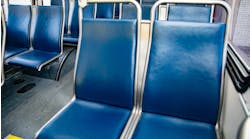All-Electric Double-Deckers Coming to the U.S.
Foothill Transit has committed to purchasing an electric version of the Alexander Dennis Inc. (ADI) double-deck bus, the Enviro500EV. It will debut in the Foothill Transit’s Southern California fleet in 2019.
The purchase of the two electric double-deck buses from ADI is made possible by a Metro Express Lanes Toll Revenue Capital Grant awarded to Foothill Transit in 2018 for $1.4 million. Foothill Transit will replace two 12-year old compressed natural gas (CNG) commuter express buses with the two ADI Enviro500EVs.
This bus acquisition is part of Foothill Transit’s commitment to go all electric by 2030.
A Comfortable Ride
Foothill Transit first demonstrated a diesel-powered ADI double-deck bus on its downtown Los Angeles routes in October 2016. Foothill Transit Executive Director Doran Barnes said the feedback from the customers was overwhelmingly positive about the ride.
“We’ve been looking for a product that could potentially replace our articulated coaches,” Barnes said. “The articulated coaches have been great in that they provide the additional capacity that we need … The downside of the articulated coaches, it’s just the nature of the design of the bus, the ride quality is not always as smooth and as comfortable as we would really like.
“This just really changes the customer experience in a really great way. We want to do it with zero emissions, in a way that people really enjoy the ride.”
Vehicle Charging
The Enviro500EV will be 13’6” tall and will be zero emissions thanks to an ADI partnership with Proterra, who will supply the battery and drivetrain technology. The buses will have 864 KwH storage on the battery pack and the expected range is 157 miles.
Foothill Transit Director of Maintenance and Vehicle Technology Roland Cordero said based off of calculations from Alexander Dennis, they’re estimating the vehicles will get 3.3 KwH per mile. The current fleet of Proterra fast charge buses get 2.1 KwH per mile.
The double-deck buses will be plug-in buses charged at the bus yard but Foothill Transit is working with the Los Angeles Department of Transportation and the Antelope Valley Transit Authority to have a layover site in downtown Los Angeles to provide opportunity charging.
“After the double-deck electric bus completes their service for the day, they would lay over in downtown for maybe about three to four hours before they go out and service the afternoon peak hours,” Cordero said.
Back at the yard, Foothill Transit will have an overhead charging system that will accommodate the height of both the Proterra 40-foot single-deck buses, as well as the Alexander Dennis double-deck bus. Cordero said they recently concluded yard discussions with Proterra on the design structure for the overhead system to accommodate both.
Driver Training
When ADI brought the diesel-powered double-deck bus, they also provided training. One of the areas related to training, was less about a double-deck bus and more about an all-electric bus.
“The operators’ performance has a much greater impact on the performance of an electric bus than it does on a CNG or diesel-powered coach,” Barnes said. “The operators are really maximizing the use of the energy that’s on board the vehicle.” He added, “So there’s certainly going to be training required across our electric fleet of vehicles … That’s a big shift in the industry, in general.”
Cordero explained that the double-deck buses also have a tag axle, which allows the bus to maneuver in and out of traffic easier because the rear wheel turns in the opposite direction than the steering wheel. He added, “From the test that we performed in 2016, the driver’s comment was that it was a lot easier to drive than a regular 40-foot bus … it was like driving a Cadillac.”
Leading Innovation
While one 40-foot CNG bus can carry approximately 38 customers, the Enviro500EV bus can carry 80 customers in the same road footprint, doubling the trip capacity with half the number of vehicles. Carrying more people in the same footprint allows Foothill Transit greater flexibility in choosing from limited stop locations in downtown Los Angeles, where road space is at a premium.
“Deploying the Enviro500EV will be transformative for Los Angeles and for the United States,” said Barnes in a press release. “No other transit agency in the country utilizes this technology on commuter express routes. And adding seats without increasing traffic congestion or local greenhouse gas emissions is the ultimate benefit for one of the nation’s most heavily traveled corridors.”
Pushing the envelope of technology comes with its share of learning and risks. Being the first to implement a heavy-duty, fast-charge, all-electric bus, Barnes said Foothill Transit knew then they would learn things they weren’t even aware of, and that they’re at a similar point now.
“We’ve learned a lot about how to manage electric power, about how to deploy electric buses, about training requirements for the coach operators, so all of that’s come out of our initial activities related to electric vehicles,” said Barnes.
“With the electric double-deck, we’re in many respects at one of those breakthrough points where we know a lot more than we knew 7 or 8 years ago when we started this process, but we also know we’re going to learn a lot as we move into using the double-deck technology.”
He said Foothill Transit’s Board of Directors is aware of the risks of implementing new technology, but they’re willing to take prudent risks in order to advance the technology and ultimately provide a really great ride for the customers in a very environmentally sensitive way.
And, as Barnes summed it up, “They’re super cool.”





